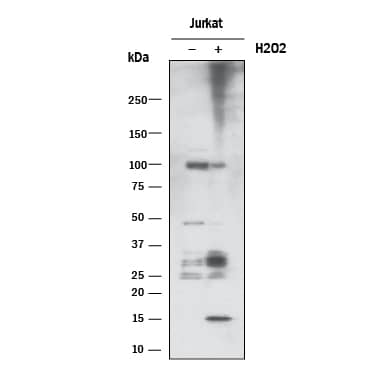Human uPAR Biotinylated Antibody Summary
Leu23-Arg303
Accession # Q03405
Customers also Viewed
Applications
Human uPAR Sandwich Immunoassay
Please Note: Optimal dilutions should be determined by each laboratory for each application. General Protocols are available in the Technical Information section on our website.
Preparation and Storage
- 12 months from date of receipt, -20 to -70 °C as supplied.
- 1 month, 2 to 8 °C under sterile conditions after reconstitution.
- 6 months, -20 to -70 °C under sterile conditions after reconstitution.
Background: uPAR
The urokinase-type Plasminogen Activator (uPA) is one of two activators that converts the extracellular zymogen plasminogen to plasmin, a serine protease that is involved in a variety of normal and pathological processes that require cell migration and/or tissue destruction. uPA is synthesized and released from cells as a single-chain (sc) pro-enzyme with limited enzymatic activity and is converted to an active two-chain (tc) disulfide-linked active enzyme by plasmin and other specific proteinases. Both the scuPA and tcuPA bind with high-affinity to the cell surface via the glycosyl phosphatidylinositol-linked receptor uPAR which serves to localize the uPA proteolytic activity. The enzymatic activity of scuPA has also been shown to be enhanced by binding to uPAR. Independent of their proteolytic activity, the uPA/uPAR interaction also initiates signal transduction responses resulting in activation of protein tyrosine kinases, gene expression, cell adhesion, and chemotaxis. uPAR can interact with integrins to suppress normal integrin adhesive function and promote adhesion to vitronectin through a high affinity vitronectin binding site on uPAR. uPAR cDNA encodes a 335 amino acid (aa) residue precursor protein with a 22 aa residue signal peptide, five potential N-linked glycosylation sites and a C‑terminal GPI-anchor site. An alternate spliced variant of uPAR encoding a secreted soluble form of uPAR also exists. Human and mouse uPAR share approximately 60% aa sequence identity and the receptor-ligand interaction is strictly species-specific.
Product Datasheets
Citations for Human uPAR Biotinylated Antibody
R&D Systems personnel manually curate a database that contains references using R&D Systems products. The data collected includes not only links to publications in PubMed, but also provides information about sample types, species, and experimental conditions.
10
Citations: Showing 1 - 10
Filter your results:
Filter by:
-
Mimicking Intermolecular Interactions of Tight Protein-Protein Complexes for Small-Molecule Antagonists
Authors: David Xu, Khuchtumur Bum-Erdene, Yubing Si, Donghui Zhou, Mona K. Ghozayel, Samy O. Meroueh
ChemMedChem
-
A Computational Investigation of Small-Molecule Engagement of Hot Spots at Protein–Protein Interaction Interfaces
Authors: David Xu, Khuchtumur Bum-Erdene, Yubing Si, Donghui Zhou, Degang Liu, Mona Ghozayel et al.
Journal of Chemical Information and Modeling
-
Small Molecules Engage Hot Spots through Cooperative Binding To Inhibit a Tight Protein–Protein Interaction
Authors: Degang Liu, David Xu, Min Liu, William Eric Knabe, Cai Yuan, Donghui Zhou et al.
Biochemistry
-
A New Class of Orthosteric uPAR·uPA Small-Molecule Antagonists Are Allosteric Inhibitors of the uPAR·Vitronectin Interaction
Authors: Degang Liu, Donghui Zhou, Bo Wang, William Eric Knabe, Samy O. Meroueh
ACS Chemical Biology
-
Probing Binding and Cellular Activity of Pyrrolidinone and Piperidinone Small Molecules Targeting the Urokinase Receptor
Authors: Timmy Mani, Degang Liu, Donghui Zhou, Liwei Li, William Eric Knabe, Fang Wang et al.
ChemMedChem
-
Genome-wide protein QTL mapping identifies human plasma kallikrein as a post-translational regulator of serum uPAR levels.
Authors: Portelli M, Siedlinski M, Stewart C, Postma D, Nieuwenhuis M, Vonk J, Nurnberg P, Altmuller J, Moffatt M, Wardlaw A, Parker S, Connolly M, Koppelman G, Sayers I
FASEB J, 2013-11-18;28(2):923-34.
Species: Human
Sample Types: Cell Lysates
Applications: Western Blot -
Small-molecule inhibition of the uPAR·uPA interaction: Synthesis, biochemical, cellular, in vivo pharmacokinetics and efficacy studies in breast cancer metastasis
Authors: Timmy Mani, Fang Wang, William Eric Knabe, Anthony L. Sinn, May Khanna, Inha Jo et al.
Bioorganic & Medicinal Chemistry
-
Noninvasive detection of acute and chronic injuries in human renal transplant by elevation of multiple cytokines/chemokines in urine.
Authors: Hu H, Kwun J, Aizenstein BD, Knechtle SJ
Transplantation, 2009-06-27;87(12):1814-20.
Species: Human
Sample Types: Urine
Applications: Antibody Array Development -
Development and validation of sandwich ELISA microarrays with minimal assay interference.
Authors: Gonzalez RM, Seurynck-Servoss SL, Crowley SA
J. Proteome Res., 2008-04-19;7(6):2406-14.
Species: Human
Sample Types: Serum
Applications: ELISA Microarray Development -
Urokinase-type plasminogen activator modulates airway eosinophil adhesion in asthma.
Authors: Brooks AM, Bates ME, Vrtis RF, Jarjour NN, Bertics PJ, Sedgwick JB
Am. J. Respir. Cell Mol. Biol., 2006-05-25;35(4):503-11.
Species: Human
Sample Types: Cell Lysates
Applications: Western Blot
FAQs
No product specific FAQs exist for this product, however you may
View all Antibody FAQsReviews for Human uPAR Biotinylated Antibody
There are currently no reviews for this product. Be the first to review Human uPAR Biotinylated Antibody and earn rewards!
Have you used Human uPAR Biotinylated Antibody?
Submit a review and receive an Amazon gift card.
$25/€18/£15/$25CAN/¥75 Yuan/¥2500 Yen for a review with an image
$10/€7/£6/$10 CAD/¥70 Yuan/¥1110 Yen for a review without an image















